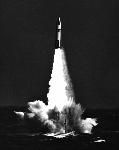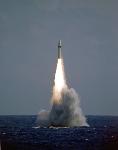





The Polaris A3 missile was the first to have a range for 2,500 miles, and, while like the A2, it was 31 feet long (1.5 in. longer than A2) and four-and-a-half feet in diameter, it weighed 35,700 pounds--4,000 more than the A2. The design of the POLARIS A3 was restricted in size by the volume available in the submarine's (SSBN) launch tube. Thus the A3 was limited to being approximately the same size as A2 but was to fly 2500 nm versus 1500 nm. Therefore, the A3 was basically a new design missile, rather than an evolution, as was A1 to A2.
The first stage (24,600 lb) usd a fiberglass motor case and nitroplasticized polyurethane propellant (21,800 lb). The second stage (10,800 lb) also used a fiberglass motor case; composite modified double base propellant (9,000 Ib), EJC (Hercules), and a Mk 11 guidance system (80 Ib). The reentry system consisted of three reentry vehicles which tilted outboard and are ejected by small rocket motor.
The A3's first test flight took place at Cape Canaveral on August 7, 1962,k and the first A3s went on patrol on September 28, 1964, when the USS Daniel Webster began its initial deployment from Charleston, South Carolina. The A3 was the first Polaris to have multiple reentry vehicles.
The 2500 nm range of the POLARIS A3 extended FBM submarines operations to the Pacific Ocean, providing greater sea room and operating area to offset the expanding Soviet anti-submarine capabilities. Another consideration for the POLARIS A3 was the need for improved accuracy from the longer-range and increased-penetrability capability against the Soviet's emerging anti-ballistic missile defense.
To meet these objectives, the A3's design included reentry vehicle concepts, improved guidance, fire control, and navigation systems; penetration aids (PenAids); and missile trajectory shaping techniques. New technologies were also considered such as, advancements in propellants, electronics, materials, and TVC concepts.
Several A2X test vehicles were launched in late 1961 and 1962 for the purpose of testing improved guidance systems and reenty vehicles for the A3. So even before POLARIS A2 became operational, POLARIS A3 design and component testing was underway.
Two POLARIS A1 missiles, AlX-50 and 51, were reconfigured for tests of an advanced TVC system based upon injection of high-density fluid (Freon 114) into the exit cone of the nozzle, creating a shock pattern and causing the main exhaust stream to deflect. On 29 September 1961, this system was successfully demonstrated during second stage flight and, after a second test 2 months later, was chosen as the baseline TVC system for the A3 second stage. The outstanding advantages of the fluid injection system were its low effective inert weight, its insensitivity to the propellant flame temperature, and the negligible constraint imposed on primary nozzle design. At this time, the rotatable nozzle concept was retained for the first stage. Guidance required significant development with the systems weight and volume allocation set at less than half that allowed in the earlier A1 and A2 missiles. Increased component accuracy was also a requirement at the longer A3 ranges. To demonstrate the effectiveness of the new inertial instruments and a simplified computer mechanization, the proposed system was flown with excellent results on seven special A2 tests during a 1-year period, starting in November 1961. An attempt was also made to obtain data on reentry vehicle materials. A special A2 flight test missile evaluated the nylon-phenolic ablative heat shield which had been selected following an extensive ground test program. Also included in the innovations which provided the major gain in performance of the POLARIS A3 over the A2 were improvements in propellants, chamber materials, and alternate velocity control techniques. The first stage chamber material was changed from steel to high-strength resin-impregnated glass roving, and the propellants were changed to formulations with higher specific impulse and density. Another significant development was the replacement of the single warhead with three reentry vehicles at fixed spacings for more efficient target coverage and reduced vulnerability to possible defenses. The first A3 flight test was conducted at Cape Canaveral on 7 August 1962. Considering the challenge and redesign involved in the development of the A3 missile, it was not until the seventh development flight that complete success was achieved. It was during the A3 development program that the concept of incorporating production components/processing was first introduced into the development phase of a program (A3X- 18) . (This approach was later to be called "production disciplines.") During June 1963, the A3X was successfully tested for the first time in a tube-launched firing at sea from the USS Observation Island (EAG-154). The first launching of a POLARIS A3 missile from a submerged submarine, the USS Andrew Jackson (SSBN-619), took place on 26 October 1963. The A3X flight test program started on 7 August 1962 and was completed on 2 July 1964. There were a total of 38 flights, of which 20 were successful, 16 partially successful, and 2 failures. Of the 20 successes, only 15 had successful reentry vehicle operation and ejection. It was only until the 15 A3X flights that the program began to have a continuous series of success.The first stage at Aerojet was plagued, in early phases, by a most negative reaction between the propellant and the nozzles. The inability to retain a set of nozzles for full duration in static firings delayed the beginning of an examination of nozzle rotation. By using a "cooler" propellant ANP 9969 (about 6000 F flame temperature) and by beefing up the nozzles to massive proportions, using tungsten throats, the nozzle erosion problem could be solved, but at the loss of some 90 rim in range. A3X-14, which was launched from EAG-154, suffered "brain scrambling" of its guidance computer, resulting in early dumping of the missile (command destructed at 17 sec). This anomaly was given the code name of CLIP. The phenomenon was found to occur at the time of umbilical disconnect and to be generated at the missile/ground support interface.
The A3X Reentry System had a series of problems which required a major effort to correct. For one, the heatshield (between ES and reentry vehicle structure) lacked structural integrity. On A3X-33 it failed, no doubt due to the thermal environment created by the reentry vehicle rocket blasts, which were more severe than originally calculated. The severe environment was confirmed in heatshield tests at Rye Canyon, under simulated altitude conditions. Deriving from these and other tests, extensive modifications were made to the heatshield to make it stronger.
The POLARIS A3 missile became operational on 28 September 1964 when the USS Daniel Webster (SSBN-626) began her initial operational patrol with 16 A3 missiles. And another milestone was reached on 25 December 1964 when the USS Daniel Boone (SSBN-629) departed Apra Harbor, Guam and began the first Pacific Ocean operational patrol. With all the Eurasian land mass covered by the 2500-mile range of the POLARIS A3 missile, the FBM System became, for the first time, a true global deterrent.
The POLARIS (A3) Operational Test (OT) program which began in September 1965 had effectiveness results which were significantly less satisfactory than those of the A3 DASO. The POLARIS A3 OT program was suspended in January 1966 and on 17 March 1966, RADM Levering Smith (Director, SPO) convened a special A3 Blue Ribbon Committee to investigate. The Blue Ribbon Committee findings and recommendations were providedduring 29 August to 2 September 1966. Preparations to implement the recommendations were conducted between September and December 1966. The POLARIS A3 Blue Ribbon Phase II Recertification (corrective action implementation) program began at POMFLANT, Charleston, South Carolina, on all delivered/deployed A3 missiles in February 1967 and was completed prior to the start of the POLARIS A3T conversion program (October 1968). The POLARIS A3 OT program resumed in November 1967 with greatly improved results.
Specifications |
|


